Fishes
Media
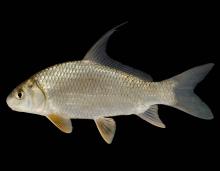
Species Types
Scientific Name
Carpiodes cyprinus
Description
Like our other carpsuckers, the quillback has a deep, rather thick body and a long, sickle-shaped dorsal fin. This silvery, hump-backed fish is widely distributed in Missouri.
Media

Species Types
Scientific Name
Catostomus commersonii
Description
The white sucker has fine scales and a short dorsal fin. The lips are covered with small bumps. A small-creek fish that occurs nearly statewide, but absent from the Bootheel lowlands and the southeastern Ozarks.
Media
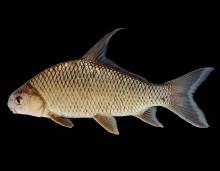
Species Types
Scientific Name
Carpiodes velifer
Description
The highfin carpsucker is named for the remarkably long first principal ray of its dorsal fin. It is rare in Missouri and is a Species of Conservation Concern.
Media
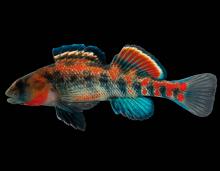
Species Types
Scientific Name
Etheostoma, Percina, Ammocrypta, and Crystallaria spp.
Description
Darters have been described as the hummingbirds of the fish world: colorful, small, and quick. Missouri has about 44 different types of darters. They are most diverse in the fast, clear, rocky streams of the Ozarks.
Media
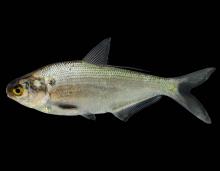
Species Types
Scientific Name
Dorosoma cepedianum
Description
The gizzard shad is one of the most common and abundant fish in Missouri. In Missouri, this schooling fish occurs in every major stream system and is most abundant in reservoirs and large rivers.
Media

Species Types
Scientific Name
Dorosoma petenense
Description
The threadfin shad occurs in the Mississippi River and its tributaries. It also occurs in mainstem reservoirs of the White River Basin and in Montrose Lake and the South Grand River in Henry County.
Media

Species Types
Scientific Name
Hiodon tergisus
Description
Mooneyes are silvery, flat-sided fishes with large eyes and prominent teeth on the jaws, roof of the mouth, and tongue. A fleshy keel runs along the midline of the belly. The eye is silvery and larger than the goldeye’s.
Media
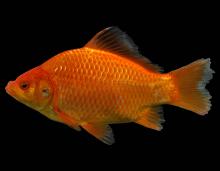
Species Types
Scientific Name
Carassius auratus
Description
Goldfish are not native to North America. They often escape into the wild from bait buckets and other causes, but there are few self-sustaining populations in Missouri.
Media
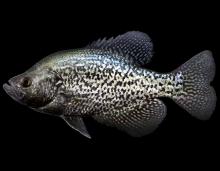
Species Types
Scientific Name
Pomoxis nigromaculatus
Description
The black crappie is a popular panfish. It is deep bodied and slab sided. The sides are silver with an irregular pattern of dark speckles. The upper jaw is long, reaching past the middle of the eye.
Media

Species Types
Scientific Name
Micropterus punctulatus
Description
The spotted bass inhabits permanent-flowing waters that are warmer and slightly more turbid than those where the smallmouth bass occurs. Note the form of its stripe and the length of its jaw.
See Also


Media

Species Types
Scientific Name
Amphiuma tridactylum
Description
The three-toed amphiuma is an eel-like, completely aquatic salamander. It has very small forelimbs and hind limbs, each with three tiny toes. In Missouri it’s found only in the Bootheel region.
Media

Species Types
Scientific Name
Siren intermedia nettingi
Description
The western lesser siren is an eel-like, aquatic salamander with external gills, small eyes, small forelimbs with four toes, and no hind limbs. In Missouri, it’s found mostly in the Bootheel and northward in counties near the Mississippi River.
About Fishes in Missouri
Missouri has more than 200 kinds of fish, more than are found in most neighboring states. Fishes live in water, breathe with gills, and have fins instead of legs. Most are covered with scales. Most fish in Missouri “look” like fish and could never be confused with anything else. True, lampreys and eels have snakelike bodies — but they also have fins and smooth, slimy skin, which snakes do not.





















